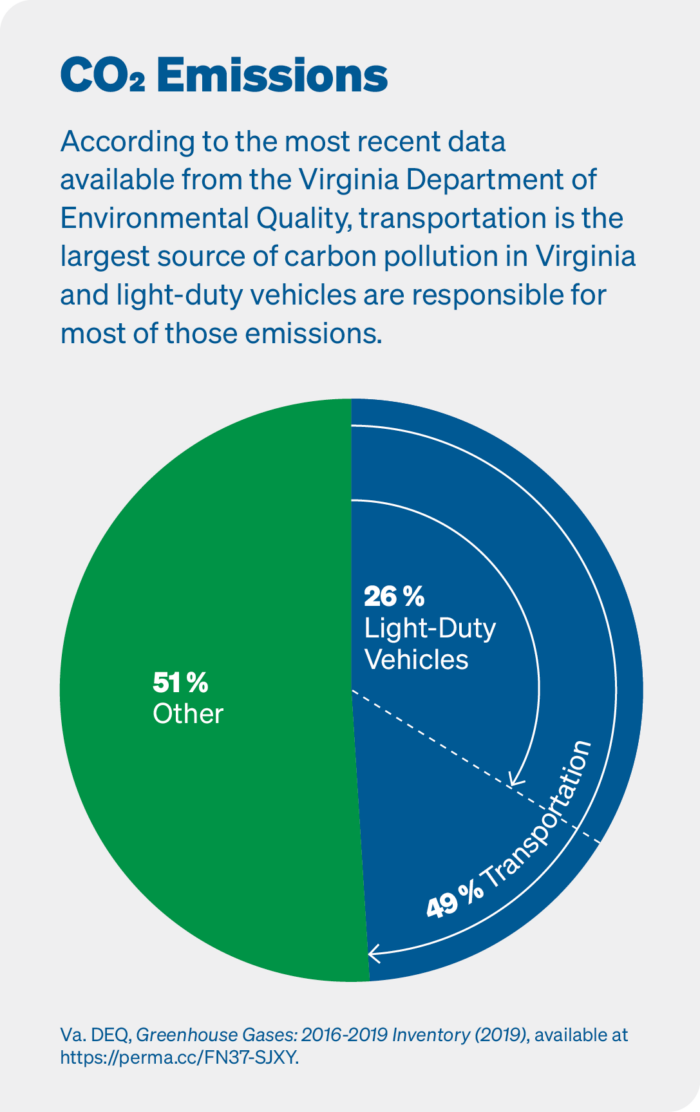TRANSFORMING TRANSPORTATION
Danny Plaugher // Virginians for High Speed Rail // danny@vhsr.com
Trip Pollard // Southern Environmental Law Center // tpollard@selcva.org
Land Use & Transportation
Why It Matters
Virginia urgently needs a cleaner, more equitable transportation system.
The Commonwealth’s approach to transportation has profound effects on our communities and our environment. For decades, funds have primarily gone to road projects—to the detriment of safer, healthier, cleaner alternatives. As a result of this asphalt-centered approach, transportation is Virginia’s largest source of climate pollution1—generating about half of all statewide carbon pollution—and it is a significant source of other air pollutants that cause serious environmental and health damage. Communities of color and under-resourced communities bear a disproportionate share of the health burdens from transportation-related pollution2.
New and expanded roads also destroy critical natural resources—such as forests and wetlands—that absorb carbon and increase communities’ resilience to flooding. They also add to the maintenance costs taxpayers must cover. They also perpetuate reliance on private vehicles, exacerbating inequities for those who cannot afford a car and those with disabilities for whom a standard vehicle is undrivable, while frequently doing little to relieve the congestion faced by those who do drive.

Graph provided by Southern Environmental Law Center
Current Landscape
Significant transportation reforms have been adopted in recent years, including increases in funding for transit, rail, and highway maintenance, the groundbreaking Transforming Rail in Virginia initiative, and the use of SMART SCALE to provide a more objective and transparent basis for selecting projects for funding. Even so, the bulk of our transportation funding is still allocated to highways3 despite decades of studies and experience showing that new and wider highways incentivize sprawling development, encourage more driving and generate more pollution, and fail to provide long-term congestion relief4 while transit investments have been shown to provide a significant return on investment.5
Efforts also continue to weaken or sidestep SMART SCALE, including using budget earmarks to fund particular projects that have yet to go through or fared well in the prioritization process. Recent changes to the program by the Commonwealth Transportation Board are almost certain to reduce funding for cleaner transportation projects—especially bicycle and pedestrian projects—and increase funding for larger highway projects. And in another major step backward, Governor Youngkin announced in June that, contrary to state law, he intends to unilaterally withdraw Virginia from the Clean Cars Standards at the end of 2024, which would reverse the most significant step the state has taken to cut tailpipe pollution.6
Opportunities
Addressing the climate crisis, spending tax dollars more wisely, and improving Virginians’ health, equity, and mobility requires moving away from a highway-focused transportation paradigm. Instead, a “fix it first” approach should be prioritized for the maintenance, resilience, and safety of existing infrastructure and the focus of our state and regional transportation budgets should shift from primarily funding highway construction to funding transit, rail, bicycle, and pedestrian facilities. This shift not only offers substantial environmental, health, and equity benefits, but the Commonwealth needs to remain economically competitive. Transit and other alternatives to driving can increase transportation equity by providing critical access to jobs, healthcare, and essential services for all, and today’s businesses and workforce increasingly seek to locate in walkable communities with good access to public transportation.
As record federal funding continues to flow into Virginia under the new infrastructure laws, we need to seize the moment to pursue competitive grants for cleaner, more equitable transportation. In addition, we must defend the data-driven, objective approach of the SMART SCALE prioritization process, oppose attempts to fund projects outside of the prioritization process, and extend those principles to other transportation funding decisions such as federal and regional funding allocations.
We also need to strengthen consideration of the climate change effects of transportation plans, proposals, and funding decisions, and ensure that state and regional plans serve to reduce—rather than exacerbate—carbon emissions and other harmful pollutants. Virginia should set a specific goal for reducing vehicle miles traveled and implement policies to achieve it. Finally, we must also ramp up funding and other efforts to accelerate vehicle electrification and expand charging infrastructure for the driving we continue to do.
Top Takeaways
Transportation is Virginia’s largest source of carbon pollution, and the health burdens of transportation-related pollution fall disproportionately on communities of color and under-resourced communities.
The bulk of our transportation funding is still allocated to highways, despite decades of studies and experience showing that new and wider highways incentivize sprawling development, encourage more driving, and fail to provide long-term congestion relief while transit investments have been shown to provide a significant return on investment.
Virginia needs to transform its transportation approach and focus on: fixing our existing infrastructure; prioritizing cleaner, more equitable transportation (primarily transit, rail, bicycle, and pedestrian facilities); accelerating vehicle electrification; and promoting sustainable, affordable, and resilient communities.
End Notes
1 Virginia Department of Environmental Quality, “Greenhouse Gases” https://perma.cc/BY8Q-FDVG.
2 “The Road to Clean Air: Benefits of a Nationwide Transition to Electric Vehicles,” American Lung Association, (2020), www.lung.org/getmedia/99cc945c-47f2-4ba9-ba59-14c311ca332a/electric-vehicle-report.pdf.
3 Farmer, Laura, “FY 2025 – 2030 Commonwealth Transportation Fund (CTF) Six-Year Financial Plan,” Commonwealth Transportation Fund presentation, (April 16, 2024), https://ctb.virginia.gov/media/ctb/agendas-and-meeting-minutes/2024/june/pres/6.pdf.
4 Todd Litman, Generated Traffic and Induced Travel: Implications for Transportation Planning (March 8, 2024), www.vtpi.org/gentraf.pdf.
5 “Economic Impacts of Public Transportation in Virginia,” Virginia Department of Rail and Public Transportation, (Feb. 2020), https://drpt.virginia.gov/wp-content/uploads/2023/05/economic-benefits-of-public-transportation-in-virginia.pdf.
6 Sarah Vogelsong, “Youngkin Pledges to Decouple Virginia from California Vehicle Emissions Standards by End of 2024,” Inside Climate News (June 5, 2024), https://insideclimatenews.org/news/05062024/youngkin-virginia-vehicle-emissions-standards-rollback.
